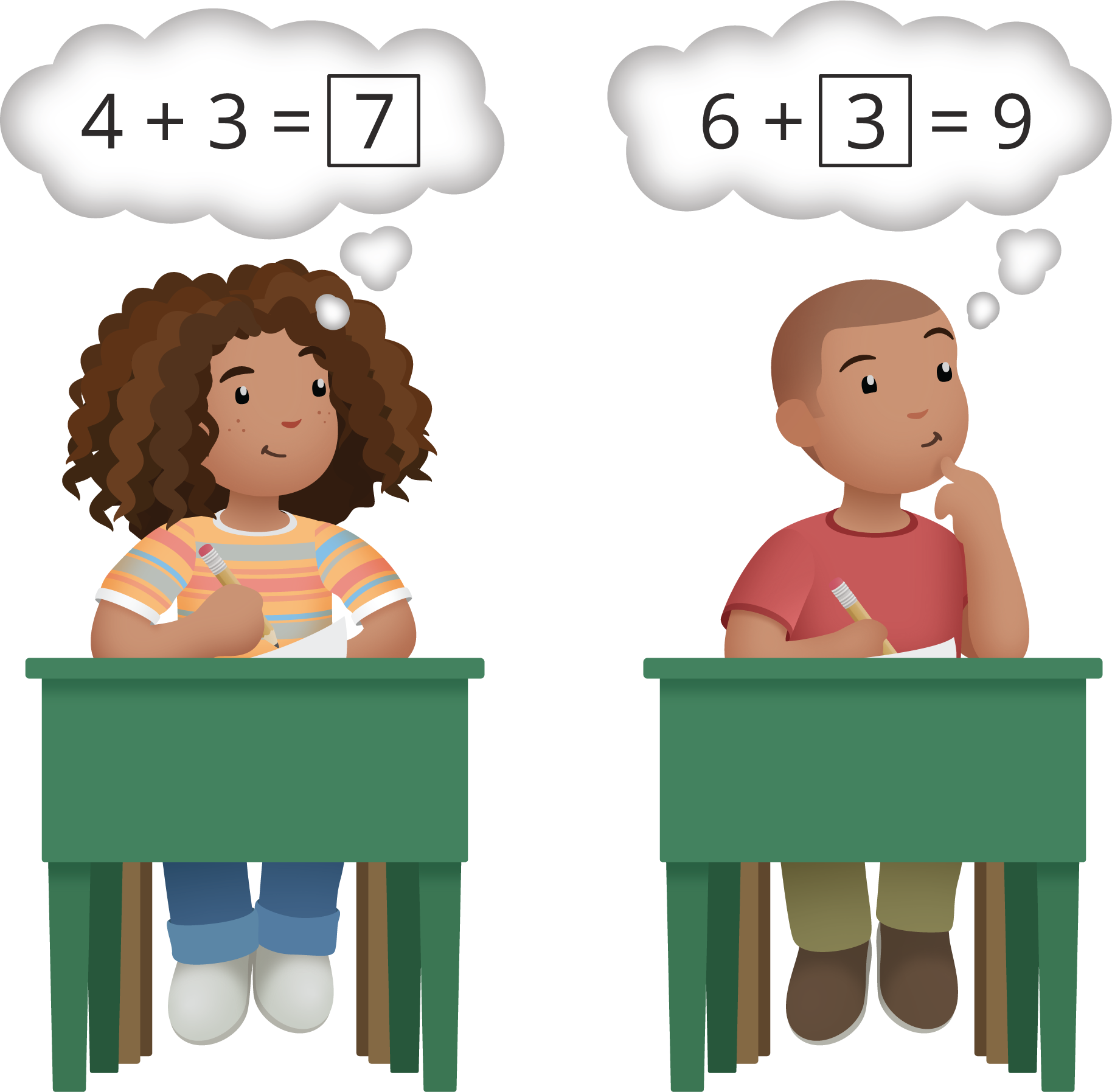Lesson 2
Relate Addition and Subtraction
Warm-up: Number Talk: Connect Addition and Subtraction (10 minutes)
Narrative
Launch
- Display one expression.
- “Give me a signal when you have an answer and can explain how you got it.”
- 1 minute: quiet think time
Activity
- Record answers and strategies.
- Keep expressions and work displayed.
- Repeat with each expression.
Student Facing
Find the value of each expression mentally.
- \(5 + 4\)
- \(4 + 5\)
- \(9 - 4\)
- \(9 - 5\)
Student Response
For access, consult one of our IM Certified Partners.
Activity Synthesis
- “Who can restate _______ 's reasoning in a different way?”
- “Did anyone have the same strategy but would explain it differently?”
- “Did anyone approach the problem in a different way?”
-
“Does anyone want to add on to____’s strategy?”
Activity 1: Cube Tower Addition and Subtraction (15 minutes)
Narrative
The purpose of this activity is for students to build an understanding of the relationship between addition and subtraction (MP7). By using two different colored cubes, students can see the two parts that make the total. They can also see when one part is removed from the total, the other part remains. Students write addition and subtraction equations that can be represented with each cube tower.
Advances: Conversing, Speaking
Required Materials
Materials to Gather
Required Preparation
- Create a tower of connecting cubes with 4 cubes of one color and 3 cubes of another color.
Launch
- Groups of 2
- Display a tower of four cubes of one color and three cubes of another color.
- “What equations could you write to match this tower?”
- If needed, “What subtraction equation could you write to match this tower?”
- “You are going to look at some pictures of connecting cubes. Use what you know about addition and subtraction to write two equations for each tower.”
Activity
- 5 minutes: independent work time
- 3 minutes: partner work time
- Monitor for students who build the images with connecting cubes and demonstrate the addition and subtraction with the tower for the problem that shows 6 and 3.
Student Facing
Student Response
For access, consult one of our IM Certified Partners.
Activity Synthesis
- Invite previously identified students to share.
- “How are the addition and subtraction equations that match this cube tower the same? How are they different?” (They have the same total and the same parts. The addition equation shows that the two parts are put together to get the total. The subtraction equations starts with the total and one part is taken away and the other part is left.)
Activity 2: Find the Unknown Number (10 minutes)
Narrative
The purpose of this activity is for students to find the number that makes an addition or subtraction equation true. The equations encourage students to use methods based on the relationship between addition and subtraction (MP7). For example, after finding the number that makes \(4 + \underline{\hspace{1 cm}} = 9\), true, students can use this to find the number that makes \(9 - \underline{\hspace{1 cm}} = 5\) true.
Supports accessibility for: Conceptual Processing, Organization
Launch
- Groups of 2
Activity
- Read the task statement.
- 5 minutes: partner work time
- Monitor for students who discuss using a known addition fact to find the unknown number in a subtraction equation.
Student Facing
Find the number that makes each equation true.
Explain to your partner how you found it.
- \(4 + \boxed{\phantom{\frac{aaai}{aaai}}} = 9\)
- \(9 - 5 = \boxed{\phantom{\frac{aaai}{aaai}}}\)
- \(\boxed{\phantom{\frac{aaai}{aaai}}} + 5 = 8\)
- \(8 - 3 = \boxed{\phantom{\frac{aaai}{aaai}}}\)
- \(7 - 4 = \boxed{\phantom{\frac{aaai}{aaai}}}\)
- \(8 = 2 + \boxed{\phantom{\frac{aaai}{aaai}}}\)
- \(8 - \boxed{\phantom{\frac{aaai}{aaai}}} = 4\)
Student Response
For access, consult one of our IM Certified Partners.
Activity Synthesis
- Invite previously identified students to share.
Activity 3: Differences I've Got (10 minutes)
Narrative
Required Materials
Materials to Gather
Launch
- Give students colored pencils and index cards.
- “Now we will revisit differences with values within 10. We will identify the differences we know the value of from memory and the ones we are still working on. Look at each expression in the chart and color in all that you know the value of from memory, just like you did on the addition chart. When you are done, you will probably have some boxes that are not colored in. These are the differences you are still working on. Write each of these differences on a card. On the back of the card, write an addition equation that can help you find the difference. Then you can use the cards to practice.”
Activity
- 8 minutes: independent work time
Student Facing

Write each difference that is not colored, on an index card.
Write an addition equation on the card that can help you find the value of the difference.

Student Response
For access, consult one of our IM Certified Partners.
Activity Synthesis
- “Choose one difference you are still working on. Tell your partner the sum that can help you find the value of the difference.”
Lesson Synthesis
Lesson Synthesis
“Today we identified the differences within 10 that we are still working on. We thought about using sums we know to help us find the value of differences. What sum would be helpful in finding the value of \(7 - 3 = \boxed{\phantom{7}}\) ? How would that sum be helpful?” ( \(3+4 = 7\) if you know you get 7 when you put together 3 and 4, then you know if you start with 7 and take away 3 you will have 4 left. )
Cool-down: Use Related Facts (5 minutes)
Cool-Down
For access, consult one of our IM Certified Partners.




